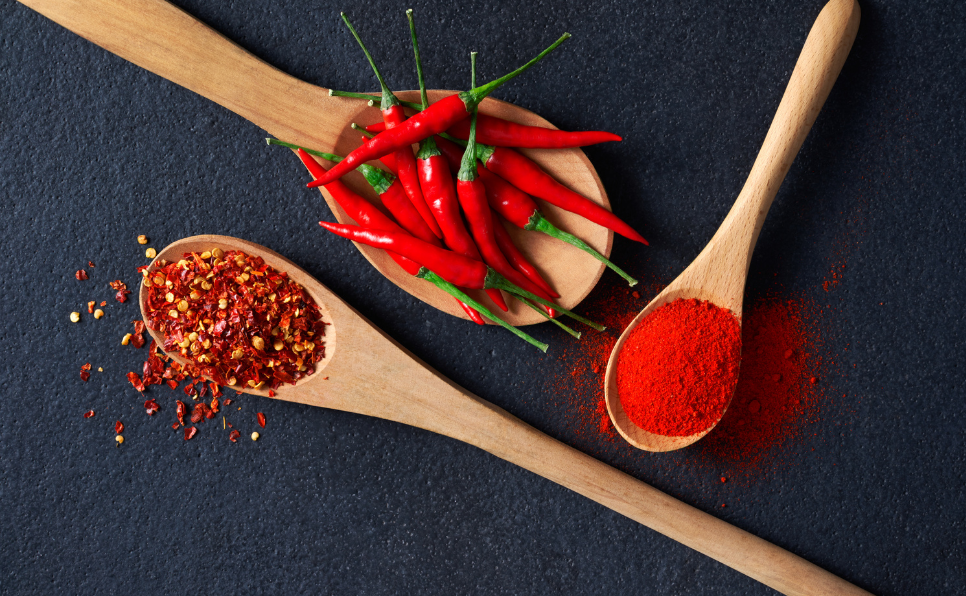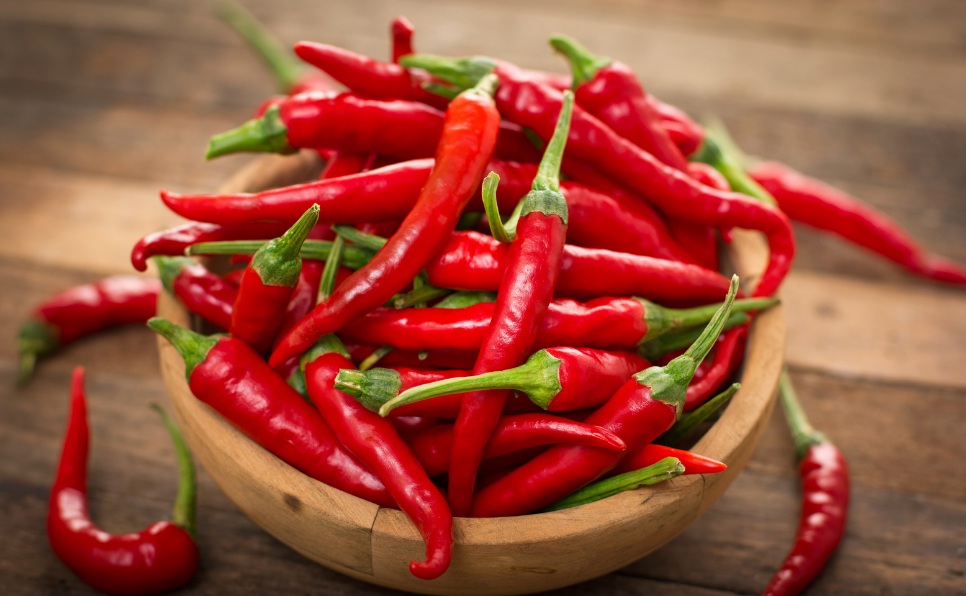Ever noticed how some people can gobble up spicy food like it’s a piece of cake while others struggle with a slightly spicy salsa dip? This difference in spice tolerance has always been a curious topic.
It’s interesting to note that not only your cultural background, exposure to spicy food, or your general health, but your genes might also be playing a part in this.
So, are our genes the reason why some people can tolerate spicy food better than others, or in other words is spice tolerance genetic?
We’re going to dive into this spicy mystery and find out why some people can handle the heat and others have very low spicy food tolerance.
From the role our genes play to how eating spicy food as a child can make a difference, let’s find out what makes us holler ‘hot, hot, hot!’ or say ‘bring on the spice’!
The Science Behind Spiciness
Did you know that spicy foods are getting more popular? A study from 2019 found that more than half of the people surveyed preferred to add some heat to their meals.
That’s twice as many people as just two years earlier in 2017! And guess what? More than 60% of people said that savory foods taste even better with a bit of spice.
Before we get into the genetic aspect, let’s first break down what actually makes food spicy.
What Causes the Spiciness?
The fiery sensation you get when eating spicy food comes from a chemical compound called capsaicin.
This compound is found in chili peppers which are part of the Capsicum plant family. Capsaicin is a kind of chemical irritant and it causes a burning sensation when it comes into contact with tissue.
Capsaicin connects with a receptor in your mouth and throat known as the TRPV1 receptor. This receptor has the job of detecting heat and pain.
When capsaicin binds to the TRPV1 receptor, it sends a signal to your brain. The brain, in turn, perceives this signal as heat or pain, which is why we feel a burning sensation when we eat spicy food.
Why Is My Spice Tolerance So Low?
Spice tolerance varies significantly among individuals, largely due to genetic differences affecting the number of capsaicin receptors in our bodies. Capsaicin is the compound found in chili peppers that gives them their heat.
People with fewer capsaicin receptors are less sensitive to spicy foods, experiencing milder reactions to the same level of spice. On the flip side, those with a higher count of these receptors are more sensitive, finding the same foods overwhelmingly spicy.
Additionally, exposure and cultural dietary habits play a role in developing tolerance over time. This blend of genetic predisposition and environmental factors explains the wide range of spice tolerance observed across different individuals.
Here is our video explaining the concept, check it out if you like.
How to Measure Spice?
To measure how spicy a food item is, we can use the Scoville Scale. The Scoville Scale was created by a pharmacist named Wilbur Scoville in 1912.
It measures the amount of capsaicin present in chili peppers by diluting them until they don’t taste spicy anymore. The higher the number on the Scoville Scale, the spicier the pepper.
For instance, a bell pepper scores 0 on the scale, meaning it has no spiciness, while pure capsaicin scores 16 million, making it the spiciest substance.
Do Genes Play a Role in Spiciness?
“Is spice tolerance genetic?” you may wonder. Well, scientists have found that our genes do play a significant role in how we handle spicy food.
Each person has a certain number of receptors, or doorways, for capsaicin in their mouth. If a person has fewer receptors, they won’t feel the spice as much and might have a higher “spiciness tolerance”.
But if they have more receptors, they’ll feel the burn more intensely.

In a study involving twins, scientists found that genes account for between 18% to 58% of our spice tolerance. This means that at least 18% of your “low spicy tolerance” or “high spicy tolerance” is due to your genes.
Genes That Matter
The gene known as TRPV1, which we talked about earlier, is linked to how we tolerate spicy food. The TRPV1 gene is responsible for creating the TRPV1 receptor that capsaicin binds to.
But these genes vary among individuals, and this variation can alter how we perceive capsaicin.
Certain people have a variation in the TRPV1 gene that makes them less sensitive to capsaicin. This means they can handle a lot more spice without feeling much discomfort. These people are sometimes referred to as “supertasters” of capsaicin.
Contrarily, some people have a version of the TRPV1 gene that makes them more sensitive to capsaicin, so even a little bit of spice can cause them a lot of discomfort. These individuals are sometimes referred to as “nontasters” of capsaicin.
The TRPV1 gene is not the only gene that can affect spicy food tolerance.
Another gene that may play a role is TAS2R38, which is associated with bitter taste perception. Bitter taste is another factor that can influence our liking or disliking of spicy food, as some spicy foods also contain bitter compounds.
Some people have a variation in the TAS2R38 gene that makes them more sensitive to bitter tastes, meaning they may find spicy food more unpleasant than others.
Apart from the TRPV1 and TAS2R38 gene, another gene that is significant to this discussion is the SCN9A gene. This gene controls a part of our nervous system that influences our pain perception.
Variations in this gene can either increase or decrease our sensitivity to pain, which in turn can affect how we perceive spiciness.
People with a particular variation in the SCN9A gene might have a high pain tolerance and hence be more comfortable eating spicy food than someone with a different variation.
Conversely, someone with a variant that heightens their sensitivity to pain may find even mildly spicy food intolerable.
Other Factors Impacting Spiciness Tolerance
Though genes are important, they’re not the only determinant of our tolerance to spicy food. Other factors also contribute to how well we can handle spicy food:
Cultural exposure
People from cultures where spicy food is common might be more tolerant to spicy food. This is because they have been exposed to spicy foods from a young age, and their taste buds have adapted accordingly.
When it comes to spicy food, people of different cultures love spices differently: Mexican food takes the top spot, followed by Chinese, Indian, and Thai food.
Growing up eating spicy food makes a difference. If you eat spicy food regularly from a young age, your tongue can get used to the burn.
This is common in the above places where food is usually spicy, and kids from these places often grow up to be adults with a higher spice tolerance. So, if you’re wondering, “why is my spice tolerance so low?”, it might be because you weren’t exposed to much spicy food as a kid.
Frequency of consumption
“Can you build a tolerance to spicy food?” Absolutely! Like many things in life, our tolerance for spicy food can be built up over time.
Even if you’re not born with a high tolerance for spice, you can still learn to handle it. How? One way is by eating spicy food more often.
This can make your mouth less sensitive to capsaicin over time. But, this won’t last forever, so you need to keep eating spicy food if you want to keep up your tolerance.
Mental attitude
Looking for ways on how to increase spice tolerance without gulping down a mouthful of spices? Believe it or not, your attitude towards spicy food can also affect your tolerance. If you approach spicy food with a positive attitude and view the burning sensation as a pleasurable experience, you might find yourself able to tolerate more spice.
In cultures where spicy food is common, people often develop a positive association with spicy flavors.

This is known as the “context effect”. This effect shows that repeated exposure to spicy food, combined with positive experiences, can change a person’s tolerance for spice.
Some researchers even found that people who enjoy taking risks or seeking thrills are more likely to enjoy eating spicy food. This suggests that the fun of eating spicy food isn’t just about the taste.
For some people, it’s also about the excitement that comes from the sensation of heat. So, your personality traits could also be a reason for your “low spicy tolerance” or “high spicy tolerance”.
Overall health
Overall health can significantly affect one’s tolerance to spicy food due to several factors.
The state of gastrointestinal health plays a critical role, as conditions like gastritis, peptic ulcers, or inflammatory bowel disease can make the consumption of spicy foods, which stimulate the digestive system, more uncomfortable.
Similarly, good oral health is essential for spice tolerance as conditions such as oral thrush or mouth ulcers can intensify the sensation of spiciness.
Metabolic health can also influence spice tolerance, with research suggesting that those with a higher body mass index (BMI) may be more sensitive to the burn from capsaicin.
Other factors include potential allergies or sensitivities to certain spices, age-related taste diminishment and health conditions like gastroesophageal reflux disease (GERD), and the effect of certain medications that may alter the sense of taste or the digestive system’s reaction to spicy food.
Ultimately, while better overall health can potentially lead to higher spice tolerance, it’s essential to listen to your body and adjust spice intake accordingly.
Dietary habits
What we eat and drink can affect our spicy food tolerance. For example, eating fatty foods or drinking milk before or after eating spicy food can help reduce the burning sensation by coating the mouth and throat.
On the other hand, eating acidic foods or drinking alcohol before or after eating spicy food can increase the burning sensation by stimulating the TRPV1 receptors.
Spicy food tolerance can change over time due to these factors. For example, if we stop eating spicy food for a long period of time, we may lose some of our tolerance and become more sensitive to it again.
How To Increase Spice Tolerance?
“Can I increase my spice tolerance?” The answer is Yes. If you are interested in increasing your spice tolerance, you can try some of these tips:
- Start with mild spices and gradually increase the intensity as you get used to it.
- Eat fatty foods or drink milk before or after eating spicy food to reduce the burning sensation.
- Avoid acidic foods or alcohol before or after eating spicy food to avoid stimulating the TRPV1 receptors more.
- Enjoy the flavor and aroma of spicy food rather than focusing on the pain.
- Have fun experimenting with different spices and cuisines.
Final Words On Spiciness Tolerance
In conclusion, while genetics do play a role in determining how well we can handle spicy food, they are not the sole determinant.
Our spicy tolerance is a complex interplay of our genetic makeup, cultural exposure, frequency of spicy food consumption, mental attitude, and overall health.
So, whether you’re a spicy food champion or looking for ways on how to increase spice tolerance, know that there are plenty of factors at play behind your preference.
References:
- https://www.sciencedirect.com/science/article/abs/pii/S0950329312001650
- https://www.sciencedirect.com/science/article/abs/pii/S0955286316302529

Dr. Sumeet is a seasoned geneticist turned wellness educator and successful financial blogger. GenesWellness.com, leverages his rich academic background and passion for sharing knowledge online to demystify the role of genetics in wellness. His work is globally published and he is quoted on top health platforms like Medical News Today, Healthline, MDLinx, Verywell Mind, NCOA, and more. Using his unique mix of genetics expertise and digital fluency, Dr. Sumeet inspires readers toward healthier, more informed lifestyles.





